Sow, grow, eat
Nonstop salads
For tasty nutritious salads the very best leaves are those picked fresh from the garden. A salad garden takes very little space and growing a variety of different leafy veges and herbs makes for ever-interesting salads. Lettuces can be grown almost all year round, but they thrive in spring and autumn when temperatures are not too cold and not too hot.
Seed can be sown straight into garden beds or containers and then thinned out to give them space as they grow. Alternatively you can sow the seed into punnets or trays of seed raising mix for planting out later. This works well in spring when there is still a risk of frost. Starting out with weed free seed raising mix makes things a lot easier too, as it can be difficult to distinguish a tiny lettuce seedling from a tiny weed.
Microgreens are easy-to-grow tasty leaves to add to salads and sandwiches. Grow them in a tray or trough on the windowsill. Snip the leaves with scissors above the growing point and you will have a continous supply of crunchy leaves for many weeks. Try rocket, celery, and pea shoots.
Sowing in trays
Take a clean seed tray, punnet or other recycled container with holes for drainage and fill it with seed raising mix. Your tray only needs to be 4 to 6cm deep. If the mix is too deep it is not only wasteful but may be too wet and cold for baby seedlings.
Sprinkle the seeds over damp seed raising mix and then cover with a thin layer - no deeper than 3mm - of the mix. Keep the seeds moist while they germinate and start to grow. Spacing small seeds like lettuces is a fiddly task. It is far easier to sprinkle the seeds and then, when they need more space to grow, lift and replant them to give them more space. This is called ‘pricking out’.
Pricking out
An ice cream stick or plant label makes a handy tool for this job. After your seedlings have their first pair of true leaves (these look similar to the parent plant and appear after the very first seed leaves called ‘cotyledons’) lever out the roots of each seedling while holding the seedling by the leaves, not the delicate stem. Using your stick to make a planting hole, transplant your tiny seedlings into containers filled with fresh mix. Drop your seedling into the hole so the so that it is buried almost up to its lowest leaves then gently firm it in. Gently firm the compost around the seedling.
Pricking out helps avoid damping off disease which can kill off young seedlings when they are too overcrowded. However, depending on how thickly you have sown your seeds (and the weather), you may decide to skip the pricking out stage and plant straight into the garden. You can also avoid the need to prick out seedlings by raising seeds in ‘cell’ trays, sowing one or two seeds into each little compartment.
Hardening off
If young seedlings are moved straight from a warm room or greenhouse into the spring garden, they may be vulnerable to cold night temperatures. ‘Hardening off’ is the simple process of acclimatising them gradually to the cold by protecting them overnight (e.g. moving them back indoors) for a week or two before planting.
Planting out
When your seedlings are ready for planting out, choose a sunny spot in your garden and enrich the soil with compost. A dibbler or narrow prowl makes easy work of spacing and planting seedlings. After planting, water thoroughly using a watering can or hose with a fine rose attachment. Water regularly to keep the soil moist as your lettuces grow.
TIPS
- Make successive sowings every few weeks for a continuous spring and summer supply of fresh greens.
- Always sow fresh seeds. The older the seeds are, the poorer the germination. Older seed, even when it does germinate, is likely to produce a weaker plant.
- Mulch with straw to conserve summer moisture.
- Feed weekly with liquid fertiliser.
- Protect young seedlings with snail bait.
Summer crops in little pots
Tomatoes, cucumbers, capsicum, zucchini, pumpkins and eggplants reward us with bumper harvests over summer and autumn. These heat lovers need a good few months of warm sunny weather to reach maturity. As soon the soil warms to a steady 16-18℃ it will be time to plant these warm season crops. In the meantime September and October are good months for growing seedlings in little pots for transplanting later.
Tomatoes, chillies and sweet peppers are fun to grow from seed with so many different colours, shapes and sizes to choose from. Sow seed in small pots or punnets. Biodegradable pots (these can be made out of newspaper or toilet rolls) make transplanting easy as seedlings can be planted pot and all, but they must not be allowed to dry out after planting.
Prepare a warm sheltered spot ready for planting out tomatoes as soon as all risk of frost has passed, ideally in soil that has not had tomatoes or any of their relatives (e.g., potatoes or peppers) grown in it for at least two seasons. If that ’s not possible, dig out the soil and replace it with fresh planting mix from the garden centre or soil from elsewhere in the garden.
Alternatively, plant your seedlings in large outdoor containers or grow bags. Patio tomatoes, chillies and peppers are great for growing in containers. Choose a good-sized pot (at least 25cm diameter for one plant) and take care to keep plants well fed and watered.
Cucumber seedlings planted every few weeks ensure a non-stop summer and autumn supply. Choose a sunny sheltered spot. Sow the large seeds directly into warm, well-drained garden soil or start them off in pots for transplanting later. If space is limited, cucumbers can be grown in large pots and trained upwards on a teepee. Regular watering and liquid feeding with a high potassium fertiliser promotes vigorous growth and heavy fruiting.
Pumpkins and squash seeds, like cucumbers, can be sown directly into the ground as soon as it has warmed or started off in small pots in a greenhouse. Choose varieties with strong disease resistant and high yields of quality fruits. Hybrid vigour offers a real advantage, especially when space is limited. Although some have been bred to be more bush-like, pumpkin and squash are essentially vines, and most need space to ramble. If you don ’t have much ground space you might give them a sturdy support to clamber over.
Zucchini (courgettes) and scallopini grow quickly and continuously through summer and autumn with phenomenal yields. Modern bush varieties are ideal for smaller gardens, although they need space - roughly a square metre per plant. Seeds can be raised them in pots for planting out later, but grow very easily and strongly when the large seed is sown directly in warm soil between October and December. Enrich the soil with compost before planting.
Sow direct!
Beans, peas, sweetcorn and root vegetables grow best when seed is sown straight into warm garden soil.
Carrots, beetroot and radishes can be sown anytime from September straight into a well-prepared sunny patch of loose crumbly soil. Water gently and keep the soil evenly moist and free of weeds as you watch for your seeds to germinate. Remove the weakest seedlings to make space for the crop to mature. Eat the thinnings as baby veges or microgreens. Beetroot is ready for harvest within about two months of sowing. Globe shaped varieties are ready to eat in the shortest time, especially the baby varieties which are lovely for cooking and serving whole.
Dwarf beans mature very quickly to produce the bulk of their crop over a two to three-week period. To achieve a non-stop supply for a family of four sow 15-20 dwarf bean seeds every three weeks from October to January.
Climbing beans take a few months to mature, but they produce about three times the yield per square metre as dwarf beans and will keep on bearing until the first frost. For climbing beans install a support structure before sowing. It could be a wire frame on a fence or a large teepee.
Time-honoured treasures
Heirloom plant varieties are those that have been passed down through generations. Their seeds come from open-pollinated (non-hybrid) plants, which means they have adapted well to local growing conditions over the decades. As well, their seed will come true to type when you collect it at the end of the growing season to grow the same crop next year.
Modern hybrid varieties are developed by plant breeders to bring out particular traits, such has high yield, colour and size or flavour. Seed collected from these plants may not grow true-to-type, and some hybrid plants have no seed at all.

15-Sep-2023

Sowing seed

Microgreens - rocket, celery leaves and pea shoots
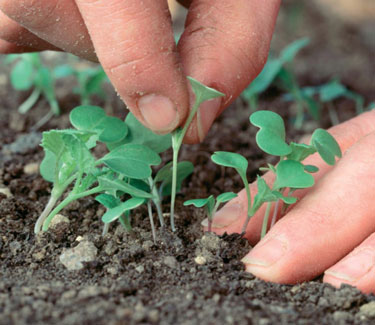
Thinning seedlings
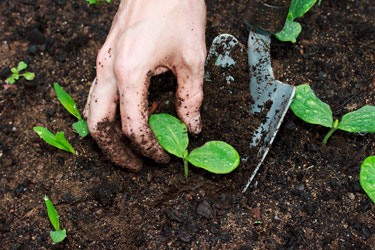
Planting seedlings
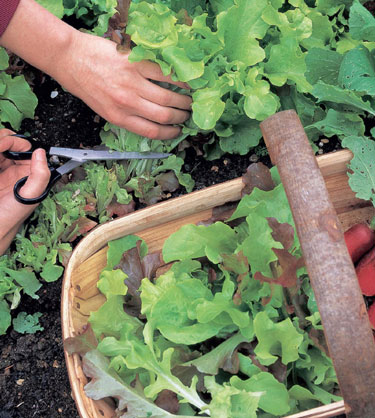
Lettuce cut-and-come-again
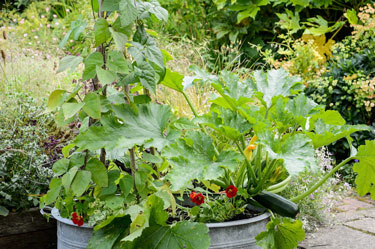
Veges grown in a large tub
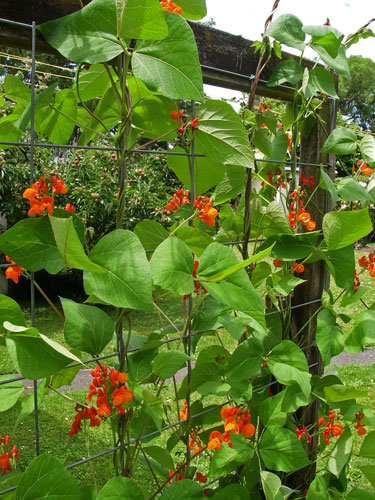
Scarlet runner beans climbing on a wire frame.

